You’re tired of crowded free-weight areas and want to build impressive shoulders using machines. But every time you hit the gym, you face the same frustrating question: “Which machines actually work?”
Here’s the thing: After analyzing over 50+ scientific studies and testing countless machines myself, I discovered something surprising – only 7 machines truly deliver remarkable shoulder development.
The best part? These machines aren’t just effective—they’re also safer and more user-friendly than traditional free weights. They’re perfect for both beginners and advanced lifters.
In this data-driven guide, I’ll show you exactly which shoulder machines to use, key benefits, workout plans and real results you can expect.
No fluff. No bro-science. Just practical, proven machine exercises that’ll transform your shoulder training.
Let’s dive in.

- 7 Best Shoulder Workout Machine
- 1. Shoulder Press Machine
- 2. Smith Machine For Shoulder Workout
- 3. Double Pulley Cable Machine
- 4. Pec Deck Machine (Reverse Fly Machine)
- 5. Lateral Raise Machine
- 6. Shrug Machine
- 7. Rowing Machine
- Best Shoulder Machines for Your Workout
- Titan Fitness Plate Loaded Deltoid and Shoulder Press Machine
- Force USA G3 All-In-One Trainer
- Nautilus Impact Shoulder Press
- Beginner Shoulder Machine Workout Plan
- Hypertrophy Focus Machine Shoulder Workout
- Shoulders Anatomy And Function
- Anterior Deltoid
- Lateral Deltoid
- Posterior Deltoid
- Trapezius
- Conclusion
- References
7 Best Shoulder Workout Machine
Here are seven gym machines designed to help you achieve an effective shoulder workout.
1. Shoulder Press Machine
The Shoulder Press Machine, sometimes called the “Military Press Machine,” is a staple in gyms and fitness centres worldwide. It is an excellent exercise for building the front and side deltoid muscles.
Machine presses have advantages over free-weight presses, providing better stability and safety.
They also offer a choice of handgrips. A neutral grip (palms facing together) focuses more on the anterior deltoid better than a pronated grip (palms forward).
This exercise requires strict movement because the bar is fixed to the rack, and the weights can go much lower. This gives the front deltoid muscles a good stretch.
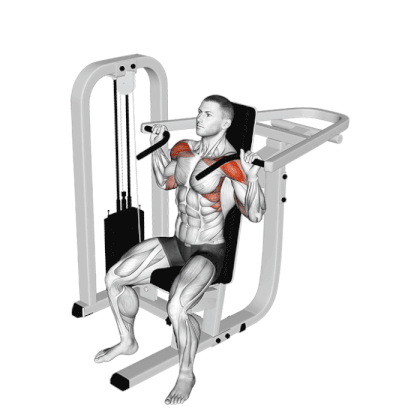
Muscles Worked
- The primary muscles worked are the front and side deltoids.
- Secondary muscles include the triceps, upper trapezius, and serratus anterior.
How Does It Work?
- Sit with your back against the backrest and your feet flat on the floor.
- Depending on the machine’s design, grip the handles with an overhand or neutral grip (palms facing each other). Make sure your grip is secure and comfortable.
- Bend your elbows at about a 90-degree angle and keep them level with your shoulders.
- Now press the handles overhead until your arms are nearly locked out.
- Lower the handles back to the starting position under controlled motion.
Optimal Sets And Reps
| Training Style | Sets | Reps |
|---|---|---|
| Strength Training | 4-5 | 6-8 |
| Hypertrophy | 3-4 | 8-12 |
| Endurance Training | 2-3 | 12-15+ |
| Power Training | 3-5 | 3-6 |
2. Smith Machine For Shoulder Workout
The Smith Machine is a gym apparatus known for its guided barbell system. This allows movements to be safer and more controlled than traditional free weights.
While it is often used for various exercises such as squats and smith machine bench presses, it is also an excellent addition to your shoulder training regimen as well.
The muscles targeted during shoulder workouts on the Smith Machine can vary based on the exercises chosen. However, here are some of the most commonly targeted shoulder muscles:
- Smith Machine Overhead Press: It primarily targets the shoulder muscles and helps to build strength and mass.
- Smith Machine Upright Row: Pulling the barbell towards your chin will engage the deltoids and upper and Middle trapezius.
- Smith Machine Behind Neck Press: This emphasizes the side and rear delts more. Press the bar up from behind your head, being careful not to strain your neck.
- Rack Pulls: Focus on the lower traps, latissimus dorsi, and erector spinae.
- Smith Machine Shrugs: This exercise primarily targets the upper trapezius and rear deltoid. It’s a simpler movement but effective for adding strength and size to the upper shoulders and neck region.
- Bent-Over Rows: Target the latissimus dorsi, rhomboids, and middle trapezius.
- Smith Machine Rear Delt Row: It targets the rear deltoids and helps to improve posture and upper back strength.
Know More: Best Smith Machine Shoulder Exercises Of All Time
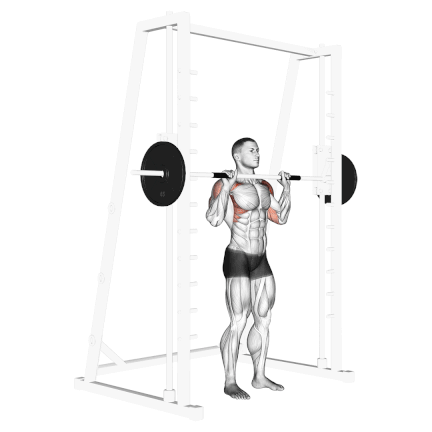
Muscles Worked During Smith Machine Shoulder Press
- The primary muscles worked are the front deltoids and side lateral deltoids.
- Secondary muscles that are worked include the triceps, trapezius, and serratus anterior.
How Does It Work?
- Adjust the height of the barbell to align with your shoulders when seated or standing.
- Load the barbell with the appropriate weight plates, ensuring they are securely fastened.
- Stand or sit with your back straight and feet shoulder-width apart for balance.
- You should grip the barbell with your palms facing away from you and your hands just wider than shoulder-width apart.
- Unhook the barbell and lower it to the starting position at shoulder height.
- Engage your core and press the barbell upwards,
- Slowly lower the barbell back down to the starting position.
3. Double Pulley Cable Machine
The Double Pulley Cable Machine is a versatile and effective piece of gym equipment offering a wide range of muscle targeting and isolation exercises. Unlike free weights, the cable machine provides constant tension throughout the range of motion.
Featuring two adjustable pulleys, this machine allows you to perform various pulling and lifting movements from numerous angles, optimizing your shoulder training for strength, hypertrophy, or endurance.
Here are some practical shoulder exercises you can perform on this versatile machine:
- Cable Lateral Raise: It offers an effective way to train the lateral Deltoid.
- Cable Front Raise: It focuses particularly on the anterior deltoid.
- Face Pulls: Great for working the rear deltoids and upper traps, also beneficial for shoulder health.
- Cable High Row: Targets upper lats and traps, great for sculpting the upper back.
- Cable Y-Raise: Focuses on the lower traps, helps improve posture and shoulder stability.
- Cable Shrugs: Targets the upper trapezius, great for building bigger shoulders.
- Cable Upright Row: It emphasizes the middle and upper trap, as well as the rear and lateral delt.
- Standing Low Cable Row: This variant targets the lats and lower traps while engaging the core for stabilization.
- Cable Pull-Through: Primarily targets the lower back and glutes, but also engages the lats, shoulder muscles during the pulling motion.
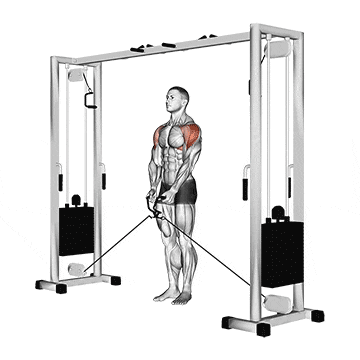
Muscle Worked During Cable Lateral Raises
Cable lateral raises focus primarily on the side deltoid muscles while working the anterior deltoid and the middle and lower traps.
- Primary Muscle Worked: Lateral deltoid.
- Secondary Muscle Worked: Anterior deltoid, posterior deltoid, trapezius, supraspinatus.
How Does It Work?
- Attach single-grip handles to the lowest point of the cable pulley system.
- The handle from the right pulley should be in your left hand, and the handle from the left pulley should be in your right hand. The cables should be crossed and pulled tightly.
- With elbows slightly bent, raise your arms to shoulder level, leading with the elbow.
- Slowly lower your arms back down until you feel a stretch in your delts and repeat.
4. Pec Deck Machine (Reverse Fly Machine)
The Pec Deck Machine is traditionally used for chest exercises but can be adapted for a Reverse Fly to target your upper back and shoulder muscles. It usually consists of a seat, back support, and two arm pads or handles that can be adjusted to various angles.
For the Reverse Fly, you’ll be using the machine in a way that’s opposite to the conventional pec deck fly.
This is simple yet effective exercise increases deltoid muscle definition and strength. The pec deck rear delt machine fly targets your upper back muscles and shoulder muscles, particularly the rear deltoids, (backside of your shoulders), Traps & rhomboid.
The Rear delt fly machine provides consistent resistance throughout the entire range of motion. Additionally, this machine offers various technical adjustments, such as grip positions, trajectory, and range of motion settings.
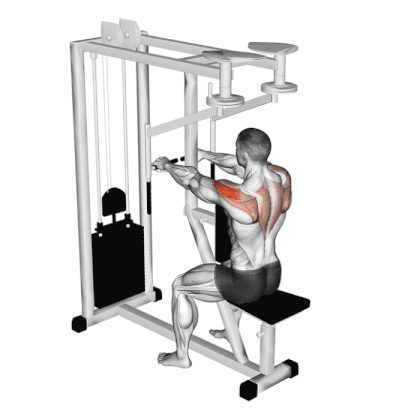
Muscles Worked
- The primary muscles worked by the pec deck machine are the rear deltoids.
- The exercise also targets secondary muscles such as the rhomboids, teres major, infraspinatus, and middle trapezius.
How Does It Work?
- The seat height and position of the handles should be adjusted to ensure a comfortable fit for your body size.
- Sit on the machine with your chest against the pad or support. Your feet should be flat on the floor, and your knees should be slightly bent. Grab the handles.
- Maintain a tall, upright posture throughout the exercise. Keep your shoulders relaxed and avoid shrugging them up.
- Maintaining a slight bend in your elbows and simultaneously pulling your arms outward and backward in an arc-like motion.
- Continue to pull until your arms are stretched out to the sides.
- Hold the contracted position briefly to emphasize the tension in your rear deltoids.
- Slowly release the tension and return your arms to their starting position.
5. Lateral Raise Machine
Many people prefer machines for lateral raises because dumbbells put pressure on the wrists with heavy weights. In addition, with dumbbells, sometimes the forearm muscles tire before the shoulder muscles, which does not allow them to be worked to the maximum.
The Lateral Raise Machine is a special gym equipment that helps isolate the deltoid muscles, mainly the side delt (lateral delt). The range of motion is controlled, so you can target these muscles without working other muscle groups.
It allows for a safer and more stable workout experience. The exercise helps build shoulder strength and mass, improve mobility and flexibility, and strengthen the upper back.
The machine consists of a seat with a backrest, a set of handles attached to weight stacks, and a lever for adjusting the weight.

Muscles Worked
- The primary muscles worked are the side deltoids.
- Secondary muscles include the upper traps, and rotator cuff.
How Does It Work?
Performing the lateral raise on this machine is fairly straightforward. Here’s how:
- Ensure the seat height aligns your shoulders with the machine’s arms.
- Sit on the seat, put your feet flat on the ground, and keep your back against the backrest.
- Place your arms under the padded levers.
- Exhale and lift the padded levers by raising your arms to the sides, focusing on contracting the lateral deltoids.
- Inhale and slowly lower the padded levers back to the starting position.
- Perform 3-4 sets of 8–12 repetitions.
6. Shrug Machine
The Shrug Machine, also called the Trap Machine, is a special piece of gym equipment that makes doing shrugs easier and effective. The lever or handles usually align with your shoulders, providing a comfortable grip and a controlled range of motion.
Unlike dumbbells or barbells, the Shrug Machine targets the upper trapezius muscles and minimizes the involvement of other muscle groups. Its ergonomic design lets you focus on muscle engagement, making it a good choice for this purpose.
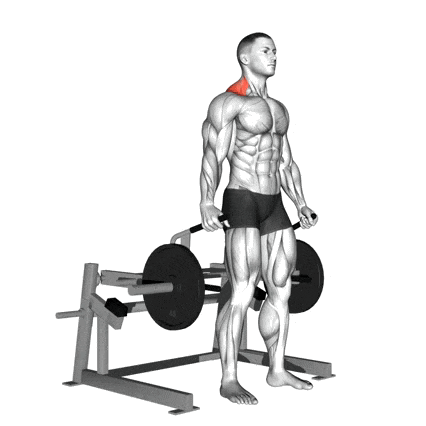
Muscles Worked
- Primarily works the trapezius muscles (upper trap mainly)
- Secondarily, it works the Mid-trap, rhomboids, and levator scapulae.
How Does It Work?
- Stand or sit (depending on the machine design) with your feet shoulder-width apart.
- Grip the handles or the lever bars with your palms facing inwards or downwards.
- Start with your shoulders relaxed and arms fully extended.
- Take a deep breath and engage your core. Next, raise your shoulders up towards your ears and squeeze your upper trapezius at the top of the movement.
- Slowly release the contraction and lower your shoulders back to the starting position.
7. Rowing Machine
The Rowing Machine, often referred to as a “rower,” is gym equipment designed to simulate the action of rowing a boat. It is an excellent tool for cardiovascular conditioning and provides substantial muscular engagement across various body parts.
The rowing machine, which consists of a sliding seat, footrests, a handle attached to a chain or rope, and a flywheel for resistance, is as versatile as it is effective.
Rowing machines are an all-in-one solution for burning calories, improving cardiovascular health, or gaining strength.

Muscles Worked
The rowing machine engages multiple muscle groups, making it a comprehensive workout option:
- Leg Muscles: Quadriceps, hamstrings, and calves are engaged during the leg push-off phase.
- Back Muscles: As you pull the handle toward you, the latissimus dorsi, rhomboids, and upper traps are worked.
- Core Muscles: Your abs, obliques, and lower back.
- Arm Muscles: Both the biceps and triceps are worked during the pulling and recovery phases.
- Shoulder Muscles: The rear deltoids are engaged when pulling the handle, while the front deltoids are involved during the recovery.
How Does It Work?
- Sit down on the sliding seat and secure your feet in the footrests.
- Grab the handle with both hands and extend your legs.
- Slide forward on the seat by bending your knees and approaching the flywheel.
- In a fluid motion, push through your heels to extend your legs and pull the handle toward your lower ribs.
- Reverse the motion to return to the initial position, extending your arms before bending your knees to slide back toward the flywheel.
Best Shoulder Machines for Your Workout
Check the best products below to find the right shoulder machines for your workout.

Titan Fitness Plate Loaded Deltoid and Shoulder Press Machine
The Titan Fitness Plate Loaded Shoulder Press Machine provides effective deltoid and shoulder workouts with independent arms for unilateral and bilateral movement, adjustable seats, and multi-grip handles for varied shoulder engagement.
- Independent arm movement for balanced muscle training
- 11-gauge steel frame for stability
- Multi-grip handles and adjustable seat height

Force USA G3 All-In-One Trainer
The Force USA G3 combines a Smith machine, power rack, and cable system for comprehensive workouts, offering a balanced and versatile solution for limited spaces, with multiple attachments and a compact design.
- Multi-functional: Smith machine, power rack, and cable system
- Adjustable pulley system
- Compact and versatile for home gyms

Nautilus Impact Shoulder Press
The Nautilus Impact Shoulder Press offers a stable path of motion that mimics free-weight presses with added ergonomic support, perfect for controlled, progressive shoulder training.
- Weight stack resistance for easy adjustments
- Ergonomic design with comfortable padding
- Commercial-grade stability for consistent use
Beginner Shoulder Machine Workout Plan
| Exercise | Sets | Reps | Rest Interval | Targeted Muscles |
|---|---|---|---|---|
| Seated Shoulder Press Machine | 3 | 10-12 | 60-90 sec | Anterior & Medial Deltoids |
| Machine Lateral Raise | 3 | 12-15 | 60 sec | Medial Deltoids |
| Rear Delt Machine (Reverse Pec Deck) | 3 | 12-15 | 60 sec | Rear Deltoids |
| Upright Row | 3 | 10-12 | 60 Sec | Medial Deltoids & Traps |
Hypertrophy Focus Machine Shoulder Workout
| Exercise | Sets | Reps | Rest Interval | Targeted Muscles |
|---|---|---|---|---|
| Smith Machine Shoulder Press | 4 | 10-12 | 60 sec | Anterior & Medial Deltoids |
| Machine Lateral Raise | 4 | 12-15 | 60 sec | Medial Deltoids |
| Cable Machine Front Raise | 4 | 8-12 | 60 sec | Anterior Delt |
| Machine Shrug | 4 | 8-12 | 60 sec | Trap |
| Reverse Pec Deck | 4 | 12-15 | 60 sec | Rear Deltoids |
Shoulders Anatomy And Function
In fitness, “shoulder exercises” refer to resistance exercises that target the deltoid muscle. The shoulder is a “ball-and-socket” joint between the upper arm’s humerus bone and the scapula bone (shoulder blade).
The six main movements that occur at the shoulder are flexion, extension, abduction, adduction, internal rotation, and external rotation.
The deltoid muscle of the shoulder consists of three separate sections or heads.
- The anterior deltoid (In front)
- Lateral deltoid (at the side)
- Posterior deltoid (behind)
To build an impressive shoulder, you need to work all three of them, along with the trapezius muscle in the upper back.

Anterior Deltoid
It is commonly called the front delt. It arises from your collar bone and inserts into your humerus (upper arm bone).
Your front delt’s main function is to move your arm up, forward, and to your center.
Lateral Deltoid
It has a few common names, such as side delts and middle delts. It arises from a little area on the shoulder blade called the acromion process and inserts into the humerus.
Your lateral delt’s main function is shoulder abduction, bringing it up to the side.
Posterior Deltoid
It is also known as the rear delt. It arises from the spine of the scapula (upper part of your shoulder blade) and inserts into the humerus.
Your posterior delts main function is moving the arm outward and backward.
Trapezius
It is often called the trap, a large triangular-shaped upper back muscle.
The main functions of the traps are to support head movement, stabilize certain arm motions, and provide stability in pushing and pulling movements.
Conclusion
Gym machines can be a great way to build stronger, more stable shoulders, improve posture, and reduce injury risk. Different handles and movement variations allow you to target all areas of the shoulders for complete development.
Some of the most popular gym machines for shoulder workouts are the shoulder press, lateral raise, and reverse fly.
You can also use the Smith and cable machines to complete a shoulder workout. The Smith machine is excellent for overhead presses, while cables allow you to hit every angle.
So, the next time you’re at the gym, remember these powerful tools for sculpting your delts.
References
- Schick EE, Coburn JW, Brown LE, Judelson DA, Khamoui AV, Tran TT, Uribe BP. A comparison of muscle activation between a Smith machine and free weight bench press. J Strength Cond Res. 2010 Mar;24(3):779-84.
- Luczak J, Bosak A, Riemann BL. Shoulder Muscle Activation of Novice and Resistance Trained Women during Variations of Dumbbell Press Exercises. J Sports Med (Hindawi Publ Corp). 2013;2013:612650. doi: 10.1155/2013/612650. Epub 2013 May 15. PMID: 26464884; PMCID: PMC4590897.
- Campos, Y.A.C., Vianna, J.M., Guimarães, M.P., Oliveira, J.L.D., Hernández-Mosqueira, C., da Silva, S.F. and Marchetti, P.H. (2020). Different Shoulder Exercises Affect the Activation of Deltoid Portions in Resistance-Trained Individuals. Journal of Human Kinetics, 75(1), pp.5–14. doi:https://doi.org/10.2478/hukin-2020-0033.
- Paoli, A., Gentil, P., Moro, T., Marcolin, G. and Bianco, A. (2017). Resistance Training with Single vs. Multi-joint Exercises at Equal Total Load Volume: Effects on Body Composition, Cardiorespiratory Fitness, and Muscle Strength. Frontiers in Physiology, [online] 8(8). doi:https://doi.org/10.3389/fphys.2017.01105.
- Sakoma, Y., Sano, H., Shinozaki, N., Itoigawa, Y., Yamamoto, N., Ozaki, T. and Itoi, E. (2010). Anatomical and functional segments of the deltoid muscle. Journal of Anatomy, [online] 218(2), pp.185–190. doi:https://doi.org/10.1111/j.1469-7580.2010.01325.x.
- Richardson E, Lewis JS, Gibson J, Morgan C, Halaki M, Ginn K, Yeowell G. Role of the kinetic chain in shoulder rehabilitation: does incorporating the trunk and lower limb into shoulder exercise regimes influence shoulder muscle recruitment patterns? Systematic review of electromyography studies. BMJ Open Sport Exerc Med. 2020 Apr 22;6(1):e000683. doi: 10.1136/bmjsem-2019-000683. PMID: 32405430; PMCID: PMC7202723.

Manish is a NASM-certified fitness and nutrition coach with over 10 years of experience in weight lifting and fat loss fitness coaching. He specializes in gym-based training and has a lot of knowledge about exercise, lifting technique, biomechanics, and more.
Through “Fit Life Regime,” he generously shares the insights he’s gained over a decade in the field. His goal is to equip others with the knowledge to start their own fitness journey.
